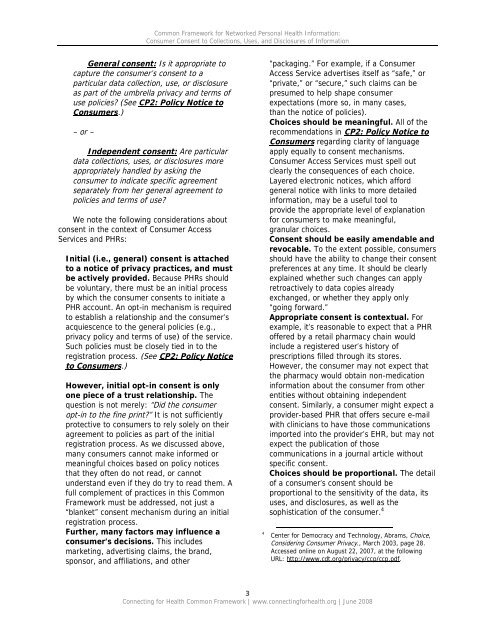CF-Consumers-Full
CF-Consumers-Full
CF-Consumers-Full
You also want an ePaper? Increase the reach of your titles
YUMPU automatically turns print PDFs into web optimized ePapers that Google loves.
Common Framework for Networked Personal Health Information:<br />
Consumer Consent to Collections, Uses, and Disclosures of Information<br />
General consent: Is it appropriate to<br />
capture the consumer’s consent to a<br />
particular data collection, use, or disclosure<br />
as part of the umbrella privacy and terms of<br />
use policies? (See CP2: Policy Notice to<br />
<strong>Consumers</strong>.)<br />
– or –<br />
Independent consent: Are particular<br />
data collections, uses, or disclosures more<br />
appropriately handled by asking the<br />
consumer to indicate specific agreement<br />
separately from her general agreement to<br />
policies and terms of use?<br />
We note the following considerations about<br />
consent in the context of Consumer Access<br />
Services and PHRs:<br />
• Initial (i.e., general) consent is attached<br />
to a notice of privacy practices, and must<br />
be actively provided. Because PHRs should<br />
be voluntary, there must be an initial process<br />
by which the consumer consents to initiate a<br />
PHR account. An opt-in mechanism is required<br />
to establish a relationship and the consumer’s<br />
acquiescence to the general policies (e.g.,<br />
privacy policy and terms of use) of the service.<br />
Such policies must be closely tied in to the<br />
registration process. (See CP2: Policy Notice<br />
to <strong>Consumers</strong>.)<br />
• However, initial opt-in consent is only<br />
one piece of a trust relationship. The<br />
question is not merely: “Did the consumer<br />
opt-in to the fine print?” It is not sufficiently<br />
protective to consumers to rely solely on their<br />
agreement to policies as part of the initial<br />
registration process. As we discussed above,<br />
many consumers cannot make informed or<br />
meaningful choices based on policy notices<br />
that they often do not read, or cannot<br />
understand even if they do try to read them. A<br />
full complement of practices in this Common<br />
Framework must be addressed, not just a<br />
“blanket” consent mechanism during an initial<br />
registration process.<br />
• Further, many factors may influence a<br />
consumer’s decisions. This includes<br />
marketing, advertising claims, the brand,<br />
sponsor, and affiliations, and other<br />
“packaging.” For example, if a Consumer<br />
Access Service advertises itself as “safe,” or<br />
“private,” or “secure,” such claims can be<br />
presumed to help shape consumer<br />
expectations (more so, in many cases,<br />
than the notice of policies).<br />
• Choices should be meaningful. All of the<br />
recommendations in CP2: Policy Notice to<br />
<strong>Consumers</strong> regarding clarity of language<br />
apply equally to consent mechanisms.<br />
Consumer Access Services must spell out<br />
clearly the consequences of each choice.<br />
Layered electronic notices, which afford<br />
general notice with links to more detailed<br />
information, may be a useful tool to<br />
provide the appropriate level of explanation<br />
for consumers to make meaningful,<br />
granular choices.<br />
• Consent should be easily amendable and<br />
revocable. To the extent possible, consumers<br />
should have the ability to change their consent<br />
preferences at any time. It should be clearly<br />
explained whether such changes can apply<br />
retroactively to data copies already<br />
exchanged, or whether they apply only<br />
“going forward.”<br />
• Appropriate consent is contextual. For<br />
example, it’s reasonable to expect that a PHR<br />
offered by a retail pharmacy chain would<br />
include a registered user’s history of<br />
prescriptions filled through its stores.<br />
However, the consumer may not expect that<br />
the pharmacy would obtain non-medication<br />
information about the consumer from other<br />
entities without obtaining independent<br />
consent. Similarly, a consumer might expect a<br />
provider-based PHR that offers secure e-mail<br />
with clinicians to have those communications<br />
imported into the provider’s EHR, but may not<br />
expect the publication of those<br />
communications in a journal article without<br />
specific consent.<br />
• Choices should be proportional. The detail<br />
of a consumer’s consent should be<br />
proportional to the sensitivity of the data, its<br />
uses, and disclosures, as well as the<br />
sophistication of the consumer. 4<br />
4<br />
Center for Democracy and Technology, Abrams, Choice,<br />
Considering Consumer Privacy., March 2003, page 28.<br />
Accessed online on August 22, 2007, at the following<br />
URL: http://www.cdt.org/privacy/ccp/ccp.pdf.<br />
3<br />
Connecting for Health Common Framework | www.connectingforhealth.org | June 2008



